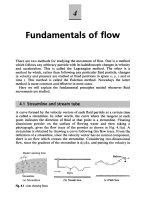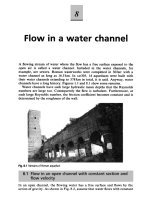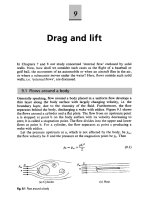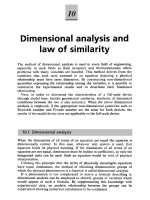Introduction to Wireless Communications
Bạn đang xem bản rút gọn của tài liệu. Xem và tải ngay bản đầy đủ của tài liệu tại đây (610.53 KB, 51 trang )
Wireless Communications
Introduction to Wireless
Communications
2
Objectives
•
Explain how the major wireless technologies are used
today
•
Describe various applications of wireless
communications technology
•
Explain the advantages and disadvantages of
wireless communications technology
•
List several different wireless technologies
3
How Wireless Technology is Used
•
Wireless
–
Describes devices and technologies that are not
connected by a wire
•
Wireless communications
–
Transmission of user data without the use of wires
•
Wireless data communications technologies include:
–
Bluetooth
–
Wireless LAN and WAN
–
Satellite
–
Cellular
4
A Wireless World
•
Wireless devices
–
Distance: 300 feet (90 meters)
–
Bandwidth: 54 Mbps
–
Can also include Voice over IP (VoIP)
•
Wireless network interface card (Wireless NIC)
–
Sends and receives data over radio waves
•
Smartphone
–
Combination mobile phone and personal digital
assistant (PDA)
5
A Wireless World (continued)
6
Bluetooth and Ultra Wide Band
•
Radio frequency identification device (RFID) tags
–
Small chips containing radio transponders
•
Can be used to track inventory
•
Bluetooth and Ultra Wide Band (UWB)
–
Wireless standards designed for very short ranges
–
Communicate using small, low-power transceivers
•
Link manager
–
Special software that helps identify other Bluetooth
devices
7
Bluetooth and Ultra Wide Band
(continued)
8
Bluetooth and Ultra Wide Band
(continued)
•
Bluetooth
–
Distance: up to 33 feet (10 meters)
–
Bandwidth: 1 Mbps
•
Ultra Wide Band
–
Distance: 150 feet (50 meters)
–
Bandwidth: 100 Mbps to 2 Gbps
•
Piconet
–
Wireless personal area network (WPAN)
–
Consists of two or more Bluetooth devices that are
exchanging data with each other
9
Bluetooth and Ultra Wide Band
(continued)
10
Satellite Networks
•
Used to transmit data over very long distance
•
Repeater
–
Located in the satellite itself
–
Simply “repeats” the same signal to another location
–
Used to transmit data from one earth station to
another
•
Transmission time is approximately 250 milliseconds
11
Satellite Networks (continued)
12
Satellite Networks (continued)
13
Cellular Networks
•
Modern cellular telephone network
–
Built around the concept of low power transmitters
–
With each “cell” handling a number of users
–
Transmission towers are spread throughout a
geographical area
–
The same radio frequency channels can be reused by
another tower
•
Located a few miles away to avoid interference
•
Maximizes the use of a limited range of frequency
channels
14
Cellular Networks (continued)
•
3G (third generation) technology
–
Uses 100% digital transmission for both voice and data
–
Transmission speed
•
Up to 2 Mbps when stationary
•
384 Kbps for slow-moving pedestrians
•
Up to 144 Kbps from a moving vehicle
•
2.5G has a maximum data transmission rate of up to
384 Kbps
15
Cellular Networks (continued)
16
Wireless Local Area Networks
•
Wireless Local Area Network (WLAN)
–
Extension of a wired LAN
•
Connecting to it through a device called a wireless access
point
•
Access point (AP)
–
Relays data signals between all of the devices in the
network
•
Each computer on the WLAN has a wireless network
interface card (NIC)
–
With an antenna built into it
17
Wireless Local Area Networks
(continued)
18
Wireless Local Area Networks
(continued)
•
Institute of Electrical and Electronic Engineers (IEEE)
standards
–
802.11a, 802.11b, and 802.11g
19
Wireless Local Area Networks
(continued)
20
Wireless Local Area Networks
(continued)
21
Wireless Local Area Networks
(continued)
22
Fixed Broadband Wireless
•
Integrated Services Digital Networks (ISDN)
–
Transmit at 256 Kbps over regular phone lines
•
T1 lines
–
Transmit at 1.544 Mbps
•
Cable modems and digital subscriber lines (DSL)
–
Generally only available in residential areas
–
Maximum transmission speed is only about 8 Mbps
23
Fixed Broadband Wireless (continued)
•
Wireless metropolitan area network (WMAN)
–
Covers a distance of up to 35 miles
–
Based on the IEEE 802.16 Fixed Broadband Wireless
standard
–
Uses small custom antennas on the roof of each building
–
Transmission speeds
•
75 Mbps at distances of up to 4 miles (6.4 km)
•
17 to 50 Mbps at distances over 6 miles (10 km)
24
Fixed Broadband Wireless (continued)
25
Wireless Wide Area Network
•
Hypertext Markup Language (HTML)
–
Standard language for displaying content from the
Internet
•
Microbrowser
–
Miniaturized version of a Web browser
•
Wireless Application Protocol version 2.0 (WAP2)
–
Provides a standard way to transmit, format, and display
Internet data
•
For small wireless devices such as cell phones









